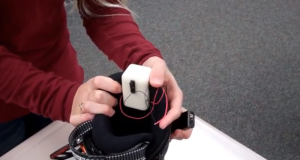In January, I relayed news about a community college in Sacramento that had used 3D printing to truly embody their role as a community institution by donating a 3D printer to the local hackerspace. Further embodying that role, the Sierra College Center for Applied Competitive Technology (CACT) has allowed local high school students to use the college’s own 3D printer to practice STEM education. The resource has already paid off with one group of students using the machine to create a prototype that may make it to full production.
The device they developed is called the Fast Forward ski sensor. Designed by Hailey Elias (age 15), Autumn Turner (age 16) and Alec Cobabe (age 16) of Colfax High School, the Fast Forward is a device that encourages good skiing posture. According to the demonstration video below, the key to good skiing is the ability of the skier to lean forward, something the students claim is often neglected by the majority of skiers. The students, avid skiers themselves, designed a small object, made up of a sensor, vibrating motors and a 3D printed case, that vibrates when a skier’s legs press back against his/her/zir ski boot, reminding the athlete to lean forward.
The project was submitted to the online invention platform Quirky, which allows a community to narrow down the site’s collection of submitted inventions. The Quirky team then gathers a group of industry experts to decide which product will be taken to market. The community further chooses specific design and engineering aspects of the invention and Quirky eventually helps get it into stores. The Head of Quirky International, Garett Van der Boom, discusses the platform’s link to education, “Quirky removes the difficulties of turning an idea into a product for inventors, and we want to do the same thing for schools so it is easier for students to experience the design process. Quirky wants to nourish students’ creativity and get them excited about inventing. Through evaluation, they get feedback from consumers and professionals so they can make improvements. We’d like to lift up a community of students unafraid to fail quickly and keep coming back with new ideas.”

The idea for submitting the idea to Quirky came from the students’ engineering teacher Jonathan Schwartz, who is creating a “Design Challenge” curriculum, with collaboration from the Sierra College STEM Collaborative, based on his experience with these lucky Colfax kids. Schwartz says, “The students couldn’t have designed and tested the ski sensor prototype without the 3D Printer supplied by Sierra College STEM. Seeing the Quirky evaluation process gave the students a new perspective. They applied their math, reasoning, writing and critical thinking skills to define a problem and work toward a solution. They went through multiple iterations of designing and testing the prototype until it was perfected.”
The Sierra STEM Collaborative is currently working with STEM programs at seven other high schools, in addition to Colfax, with CACT’s director, Carol Pepper-Kittredge, saying, “We’ve worked with STEM teachers to develop creative and innovative learning environments specific to manufacturing, product development and engineering career pathways. With Quirky breaking down the barriers, STEM teachers engaging students in the design process and opportunities here at the Sierra College for students to further their skills, we are building a future workforce of innovators who will be assets to employers and our nation’s economy.”
It’s exciting to hear about educators embracing real world experience as a method for teaching STEM education to their students. And, as we’ve seen from stories such as these, the students really seem to benefit from such hands-on learning. My hope is that administrators and teachers in other areas of education, including literature and the social sciences, will see the advantages of lessons rooted in tangible outcomes.
Source: PR Web



